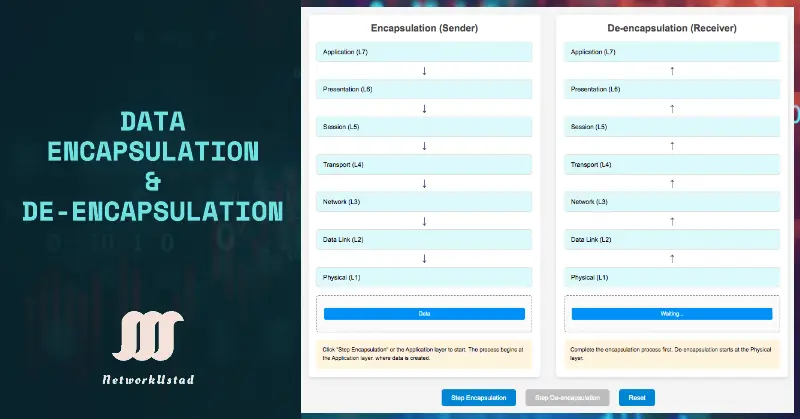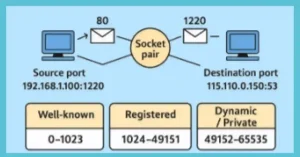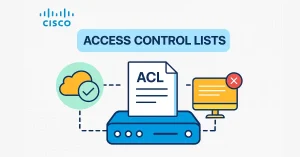Data encapsulation and de-encapsulation are crucial for transmitting information across computer networks. Encapsulation involves wrapping data in a specific format before sending it over the network, ensuring it can traverse various communication mediums and reach its destination intact.
On the other hand, de-encapsulation is the process of unwrapping and extracting the original data at the receiving end. These processes are pivotal in maintaining data integrity, enhancing efficiency, and facilitating seamless communication within complex network architectures. Furthermore, in this exploration, we delve into the intricacies of data encapsulation and de-encapsulation to unravel their significance in networking.
Data Encapsulation
In the previous article, we learned various layers of the OSI reference model. We have discussed the function of each layer and its relationship with other layers and the remote end. For example, the session layer at the source will interact with the session layer of the destination. Each layer adds a header for this interaction in front of the data from the earlier layer. This header contains control information related to the protocol used at that layer. This process is the encapsulation Process. The steps of the encapsulation process are:
- The upper layers (Application layer, Presentation layer, and Session layer) convert the message to data and send it to the Transport layer, the heart of the OSI Model.
- The Transport layer converts the data into segments and sends it to the Network layer.
- The Network layer converts the segments to packets and sends these packets to the Data Link layer.
- The Data Link layer converts the packets to frames and then sends frames to the Physical layer.
- The Physical layer converts the frames to binary 1s and 0s in the shape of electrical or light signals and sends them across the network.
The OSI Model: A Quick Overview
The OSI model consists of seven layers, each responsible for specific networking functions. Understanding these layers is crucial for grasping encapsulation and decapsulation:
- Application Layer (Layer 7): Provides network services to end-user applications (e.g., HTTP, FTP).
- Presentation Layer (Layer 6): Handles data formatting, encryption, and compression.
- Session Layer (Layer 5): Manages sessions between applications.
- Transport Layer (Layer 4): Ensures reliable data transfer (e.g., TCP, UDP).
- Network Layer (Layer 3): Handles logical addressing and routing (e.g., IP).
- Data Link Layer (Layer 2): Provides error-free transfer of data frames (e.g., Ethernet).
- Physical Layer (Layer 1): Transmits raw bits over a physical medium.
Each layer interacts with its counterpart on the receiving end, and encapsulation/decapsulation facilitates this communication.
Encapsulation Process: Step-by-Step
The encapsulation process occurs as data moves down the OSI model. Below is a detailed breakdown of how each layer contributes:
1. Application Layer (Layer 7)
- Role: The process begins when an application (e.g., a web browser) generates data, such as an HTTP request.
- Encapsulation: The data is created in a format specific to the application (e.g., HTML, JSON). No headers are added at this stage; the data is considered the payload for the next layer.
- Output: Raw application data.
2. Presentation Layer (Layer 6)
- Role: This layer translates data into a standardized format, handling encryption, compression, or character encoding (e.g., UTF-8, JPEG).
- Encapsulation: The data may be reformatted or encrypted, but typically no header is added unless specific protocols require it.
- Output: Formatted data.
3. Session Layer (Layer 5)
- Role: Manages sessions between applications, ensuring proper communication channels.
- Encapsulation: Minimal encapsulation occurs here, as session management is often handled by protocols in other layers (e.g., TCP). Some protocols may add session-specific metadata.
- Output: Session-managed data.
4. Transport Layer (Layer 4)
- Role: Ensures reliable data transfer using protocols like TCP or UDP.
- Encapsulation: The data is segmented into smaller chunks (segments for TCP, datagrams for UDP). A transport header is added, containing:
- Source and destination port numbers.
- Sequence numbers (for TCP).
- Error-checking information.
- Output: Segment (TCP) or datagram (UDP).
5. Network Layer (Layer 3)
- Role: Handles logical addressing and routing using protocols like IP.
- Encapsulation: The segment/datagram is encapsulated into a packet. A network header is added, including:
- Source and destination IP addresses.
- Time-to-live (TTL) for packet routing.
- Output: Packet.
6. Data Link Layer (Layer 2)
- Role: Ensures error-free data transfer between adjacent nodes using protocols like Ethernet.
- Encapsulation: The packet is encapsulated into a frame. A data link header and trailer are added, containing:
- Source and destination MAC addresses.
- Frame check sequence (FCS) for error detection.
- Output: Frame.
7. Physical Layer (Layer 1)
- Role: Converts the frame into raw bits for transmission over the physical medium (e.g., cables, fiber).
- Encapsulation: No additional headers are added; the frame is encoded into electrical signals, light pulses, or radio waves.
- Output: Transmitted bits.
By the end of encapsulation, the original data is wrapped in multiple layers of headers (and possibly a trailer), forming a complete frame ready for transmission.
Decapsulation Process: Step-by-Step
Decapsulation occurs as data moves up the OSI model at the receiving device. Each layer removes and processes its corresponding header/trailer:
1. Physical Layer (Layer 1)
- Role: Receives raw bits and converts them into a frame.
- Decapsulation: The bits are decoded into a frame and passed to the Data Link layer.
- Output: Frame.
2. Data Link Layer (Layer 2)
- Role: Checks for errors and forwards the frame to the correct device.
- Decapsulation: The data link header and trailer are removed. The FCS is used to verify data integrity. If valid, the packet is extracted and passed to the Network layer.
- Output: Packet.
3. Network Layer (Layer 3)
- Role: Verifies the destination IP address and routes the packet.
- Decapsulation: The network header is removed, and the segment/datagram is passed to the Transport layer.
- Output: Segment or datagram.
4. Transport Layer (Layer 4)
- Role: Reassembles segments (for TCP) and checks for errors.
- Decapsulation: The transport header is removed, and the data is reassembled into its original form before being passed to the Session layer.
- Output: Application data.
5. Session Layer (Layer 5)
- Role: Maintains session continuity.
- Decapsulation: Any session-specific metadata is processed, and the data is passed to the Presentation layer.
- Output: Session-managed data.
6. Presentation Layer (Layer 6)
- Role: Translates data into a format usable by the application (e.g., decrypting, decompressing).
- Decapsulation: The data is reformatted, and any encryption is removed.
- Output: Application-ready data.
7. Application Layer (Layer 7)
- Role: Delivers the data to the receiving application (e.g., a web browser displaying a webpage).
- Decapsulation: The final data is presented in its original form, completing the communication process.
- Output: Original data.
The Simulator below illustrates the data encapsulation and data de-encapsulation process in the interactive way. You can see what is done with the data on each layer.
Data Encapsulation and Data De-Encapsulation Simulator
Encapsulation (Sender)
De-encapsulation (Receiver)
Practical Example: Sending an Email
To illustrate encapsulation and decapsulation, consider sending an email:
- Application Layer: You compose an email in an application (e.g., Gmail). The email content is the data.
- Presentation Layer: The email is formatted (e.g., as HTML or plain text) and possibly encrypted (e.g., TLS).
- Session Layer: A session is established between your email client and the server.
- Transport Layer: The email data is segmented, and a TCP header is added with port numbers (e.g., port 587 for SMTP).
- Network Layer: The segments are encapsulated into packets with IP addresses (e.g., your IP and the mail server’s IP).
- Data Link Layer: The packets are framed with MAC addresses and an FCS for error checking.
- Physical Layer: The frame is transmitted as bits over the internet.
At the receiving mail server:
- Physical Layer: Bits are received and converted into a frame.
- Data Link Layer: The frame is checked for errors, and the packet is extracted.
- Network Layer: The packet’s IP address is verified, and the segment is extracted.
- Transport Layer: The TCP header is removed, and segments are reassembled.
- Session Layer: The session is maintained.
- Presentation Layer: The email is decrypted and formatted.
- Application Layer: The email is delivered to the recipient’s inbox.
Why Encapsulation and Decapsulation Matter
Encapsulation and decapsulation are critical for several reasons:
- Interoperability: They enable devices from different vendors to communicate by adhering to standardized protocols.
- Error Handling: Headers include error-checking mechanisms (e.g., FCS, checksums) to ensure data integrity.
- Routing: Network and data link headers provide addressing information for accurate data delivery.
- Modularity: Each layer handles specific tasks, simplifying network design and troubleshooting.
- Security: Encryption and authentication data added during encapsulation protect sensitive information.
Common Protocols Involved
The following protocols play key roles in encapsulation/decapsulation:
- Application Layer: HTTP, FTP, SMTP, DNS.
- Presentation Layer: SSL/TLS, JPEG, MPEG.
- Session Layer: NetBIOS, RPC.
- Transport Layer: TCP, UDP.
- Network Layer: IP, ICMP.
- Data Link Layer: Ethernet, Wi-Fi (802.11), PPP.
- Physical Layer: DSL, fiber optics, Ethernet cables.
Challenges and Considerations
While encapsulation and decapsulation are robust processes, they come with challenges:
- Overhead: Each layer adds headers, increasing the data size and potentially slowing transmission.
- Complexity: Multiple protocols and layers can complicate troubleshooting.
- Security Risks: Improperly handled headers can expose vulnerabilities (e.g., IP spoofing).
- Performance: Decapsulation requires processing power, which can impact resource-constrained devices.
To mitigate these, network engineers optimize protocols, use compression, and implement efficient hardware.
Conclusion
Encapsulation and decapsulation are the backbone of data communication in the OSI model, enabling seamless and reliable data transfer across networks. By understanding how each layer adds and removes headers, networking professionals can design, troubleshoot, and optimize systems effectively. This comprehensive guide has explored the step-by-step processes, practical examples, and their significance in modern networking. Whether you’re studying for a certification like CCNA or simply curious about how the internet works, mastering encapsulation and decapsulation is a vital step toward networking expertise.
For further learning, explore related topics like the TCP/IP model, packet sniffing, or network security protocols. Stay curious, and keep networking!
FAQs
What is encapsulation in the OSI model?
Encapsulation is the process of adding headers (and sometimes trailers) to data as it moves down the OSI layers from Application to Physical. Each layer wraps the data with protocol-specific metadata, like IP addresses or MAC addresses, to ensure proper transmission. This prepares the data for delivery across the network.
How does decapsulation work in networking?
Decapsulation occurs when a receiving device removes headers (and trailers) as data moves up the OSI layers from Physical to Application. Each layer processes its header, extracts the data, and passes it to the next layer. This restores the original data for the receiving application.
Which OSI layers add headers during encapsulation?
The Transport, Network, and Data Link layers primarily add headers during encapsulation. The Transport layer adds port numbers (e.g., TCP/UDP), the Network layer adds IP addresses, and the Data Link layer adds MAC addresses and error-checking data. The Physical layer transmits the final frame without adding headers.
Why is encapsulation important in networking?
Encapsulation ensures data is properly formatted, addressed, and routed across networks. It enables interoperability between devices, supports error checking, and facilitates secure data transfer. Without encapsulation, reliable communication would be impossible.
What is the role of the Data Link layer in encapsulation?
The Data Link layer encapsulates packets into frames by adding a header with MAC addresses and a trailer with error-checking data (FCS). It ensures error-free data transfer between adjacent network nodes. During decapsulation, it verifies the frame’s integrity before passing the packet upward.
Can encapsulation affect network performance?
Yes, encapsulation adds headers, increasing data size and transmission overhead, which can slow performance. Processing these headers during decapsulation also requires computational resources. Efficient protocols and hardware optimization help mitigate these impacts.
What protocols are commonly involved in encapsulation?
Common protocols include HTTP/SMTP (Application layer), TCP/UDP (Transport layer), IP (Network layer), and Ethernet (Data Link layer). These protocols add specific headers to facilitate data transfer. Each layer’s protocol ensures compatibility and reliable communication.





